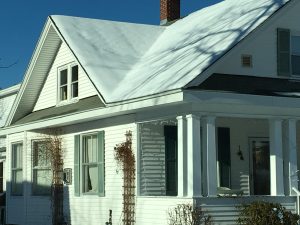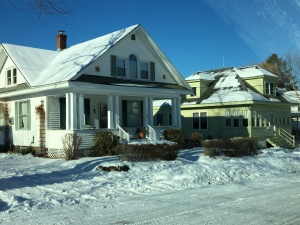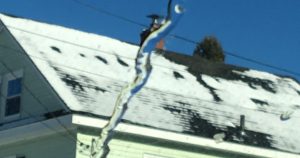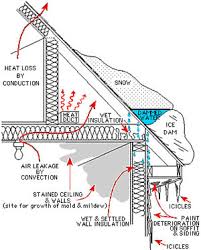
White makes right: Snow shows that the right side is better insulated than the left.
With a fresh blanket of snow on the roofs, and the furnaces churning in the basements, it’s a fine time to play “read the roof.” This amusing/depressing game can reveal a number of secrets that your house might otherwise keep to itself.
Like, where is there insulation, and where is there not?
On the right side of this first example, you can see a clear line where the insulation ends, over the “knee wall” portion of the third floor. (See cross section below.) Escaping heat is melting the snow faster on the lower part than the upper. On the left side of that big dormer, there are a couple of rafter bays where escaping heat has melted the snow completely, suggesting no insulation; and between them, a pretty well insulated bay. Chimneys are almost always good at conducting heat from the inside to the outside, melting snow in a circle around their base.

Action shot: Thermal bridging under way.
Here’s a classic case of “thermal bridging.” On the left side of this roof, the wooden rafters that support the roof are allowing heat to escape faster than the insulated bays in between them. The migrating heat melts the snow over the rafters a bit faster, creating those parallel lines. It’s like an X-ray of the roof framing.
Extra credit: The overshot eave of the bungalow gets no heat from the interior, so see how the snow there is slightly deeper there?

Compare and contrast: An efficiency freak does not live in my neighbor’s house. She may not have story-book insulation, but she has a life.

Can you spot the hot spots? (That line down the middle is ice on my windshield. Sorry.)
OK, that’s my house. I’m an energy efficiency geek. The home of my neighbor is more normal. In old houses, those rafter bays are only about 4 inches deep, which really limits the amount of insulation you can cram in there. Both these houses would have been built with no insulation, or perhaps a product from the “Yankee Ingenuity” line. (Newspaper isn’t uncommon; I have also seen sawdust and old clothing.) Updating of insulation tends to happen piecemeal, willy-nilly, as the years and energy crises and remodeling projects go by. The result is usually not “blanket of snow,” but “crazy quilt of snow.”
This last one is frankly open to interpretation. It’s an odd pattern. We can see again that the cap of the house — the flat part of the third floor ceiling–is better insulated than the sloping part over the eave. On that lower part, those narrow white stripes suggest that the rafters under the roof are actually the most insulating element of the “roof assembly,” and the rafter bays between them are letting heat out faster. And both the chimney and the sewer vent stack are acting as thermal bridges.
The puzzling part is that row of hot dots. Something about the insulation pattern directs rising heat to these distinct spots in the roofing structure. Those hot spots may not be very big, but once the black roof is uncovered, it heats quickly in the sun and enlarges the dot.
For reference purposes, a cross section of a basic roof. And the ice dams that occur when insulation is of the crazy-quilt variety.

Cross section. That swirly stuff is insulation, but only in new or really well renovated houses.